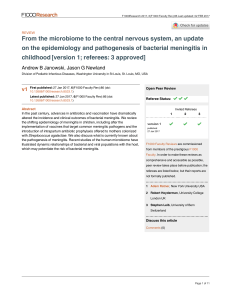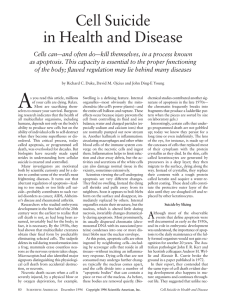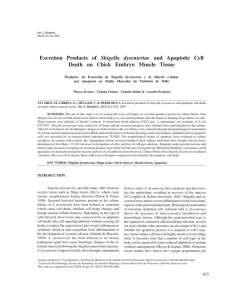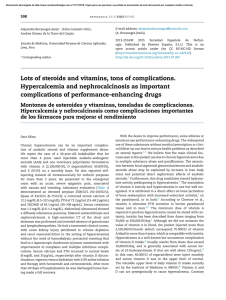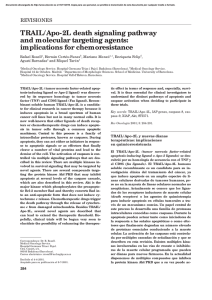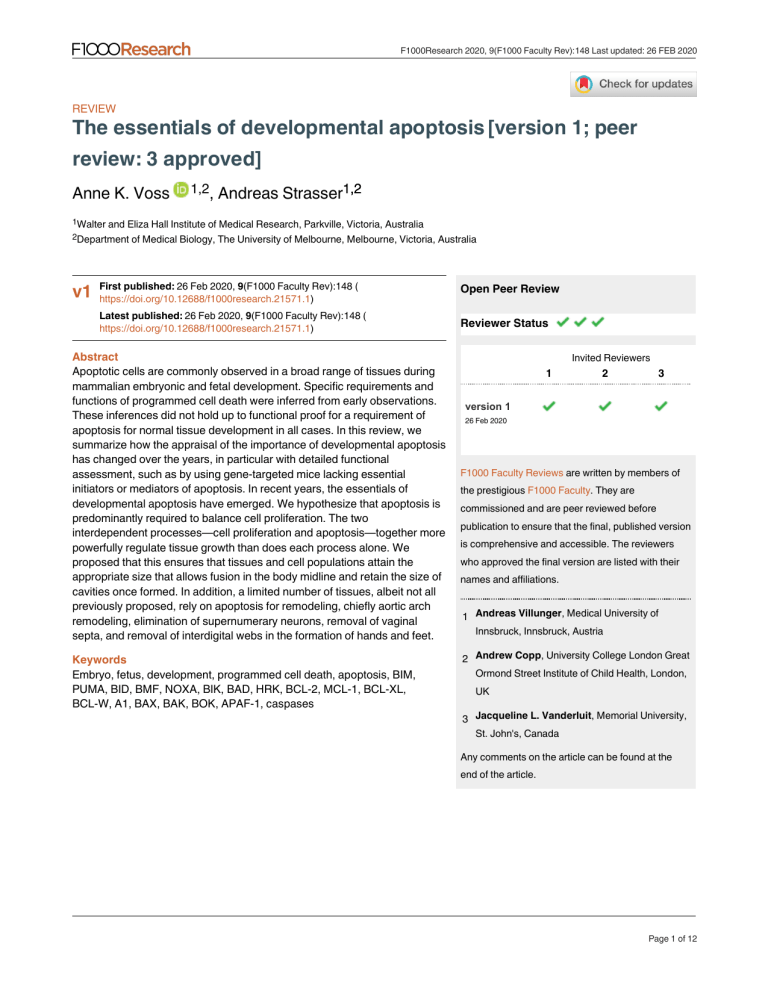
F1000Research 2020, 9(F1000 Faculty Rev):148 Last updated: 26 FEB 2020 REVIEW The essentials of developmental apoptosis [version 1; peer review: 3 approved] Anne K. Voss 1,2, Andreas Strasser1,2 1Walter and Eliza Hall Institute of Medical Research, Parkville, Victoria, Australia 2Department of Medical Biology, The University of Melbourne, Melbourne, Victoria, Australia v1 First published: 26 Feb 2020, 9(F1000 Faculty Rev):148 ( https://doi.org/10.12688/f1000research.21571.1) Open Peer Review Latest published: 26 Feb 2020, 9(F1000 Faculty Rev):148 ( https://doi.org/10.12688/f1000research.21571.1) Reviewer Status Abstract Apoptotic cells are commonly observed in a broad range of tissues during mammalian embryonic and fetal development. Specific requirements and functions of programmed cell death were inferred from early observations. These inferences did not hold up to functional proof for a requirement of apoptosis for normal tissue development in all cases. In this review, we summarize how the appraisal of the importance of developmental apoptosis has changed over the years, in particular with detailed functional assessment, such as by using gene-targeted mice lacking essential initiators or mediators of apoptosis. In recent years, the essentials of developmental apoptosis have emerged. We hypothesize that apoptosis is predominantly required to balance cell proliferation. The two interdependent processes—cell proliferation and apoptosis—together more powerfully regulate tissue growth than does each process alone. We proposed that this ensures that tissues and cell populations attain the appropriate size that allows fusion in the body midline and retain the size of cavities once formed. In addition, a limited number of tissues, albeit not all previously proposed, rely on apoptosis for remodeling, chiefly aortic arch remodeling, elimination of supernumerary neurons, removal of vaginal septa, and removal of interdigital webs in the formation of hands and feet. Keywords Embryo, fetus, development, programmed cell death, apoptosis, BIM, PUMA, BID, BMF, NOXA, BIK, BAD, HRK, BCL-2, MCL-1, BCL-XL, BCL-W, A1, BAX, BAK, BOK, APAF-1, caspases Invited Reviewers 1 2 3 version 1 26 Feb 2020 F1000 Faculty Reviews are written by members of the prestigious F1000 Faculty. They are commissioned and are peer reviewed before publication to ensure that the final, published version is comprehensive and accessible. The reviewers who approved the final version are listed with their names and affiliations. 1 Andreas Villunger, Medical University of Innsbruck, Innsbruck, Austria 2 Andrew Copp, University College London Great Ormond Street Institute of Child Health, London, UK 3 Jacqueline L. Vanderluit, Memorial University, St. John's, Canada Any comments on the article can be found at the end of the article. Page 1 of 12 F1000Research 2020, 9(F1000 Faculty Rev):148 Last updated: 26 FEB 2020 Corresponding authors: Anne K. Voss ([email protected]), Andreas Strasser ([email protected]) Author roles: Voss AK: Conceptualization, Funding Acquisition, Investigation, Supervision, Visualization, Writing – Original Draft Preparation, Writing – Review & Editing; Strasser A: Conceptualization, Funding Acquisition, Investigation, Supervision, Writing – Original Draft Preparation, Writing – Review & Editing Competing interests: No competing interests were disclosed. Grant information: The authors were supported by the Australian Government through National Health and Medical Research Council grants and fellowships and by the Victorian State Government Operational Infrastructure Support. The funders had no role in study design, data collection and analysis, decision to publish, or preparation of the manuscript. Copyright: © 2020 Voss AK and Strasser A. This is an open access article distributed under the terms of the Creative Commons Attribution License, which permits unrestricted use, distribution, and reproduction in any medium, provided the original work is properly cited. How to cite this article: Voss AK and Strasser A. The essentials of developmental apoptosis [version 1; peer review: 3 approved] F1000Research 2020, 9(F1000 Faculty Rev):148 (https://doi.org/10.12688/f1000research.21571.1) First published: 26 Feb 2020, 9(F1000 Faculty Rev):148 (https://doi.org/10.12688/f1000research.21571.1) Page 2 of 12 F1000Research 2020, 9(F1000 Faculty Rev):148 Last updated: 26 FEB 2020 Introduction The observation that cells can undergo cell death during development was first made in the 1920s (reviewed in 1). The morphology of these dying cells was found to be distinctly different than that observed in necrotic cells (for example, cells subjected to injury). Isolated cells or at most small clusters of cells undergo cell death during normal development. Cells undergoing cell death during embryonic development shrink rather than rupture as seen in necrosis (Figure 1); cell nuclei condense in what is termed pyknosis (from the Greek pykno, meaning thick, compact, or dense) and ultimately fragment. The components of such dying cells are packaged into cytoplasmic membrane–enclosed vesicles awaiting phagocytosis by other cells. In contrast, during necrosis, which can occur during injury and inflammation, larger areas of tissue are usually affected, cells swell, the plasma membrane and nuclear envelope rupture, and cell contents spill out. The predictable time course and location of the dying cells during development suggested that it was a regulated process and the term programmed cell death was used to indicate this concept. Based on the time course and location, the essential roles of programmed cell death during development—including requirement for tissue invagination and closure, union of body halves, lumen formation, bifurcation, regression of rudimentary organs, and cell differentiation—were inferred1. Later, the electron microscopic characteristics of the dying cells were described and the term apoptosis (from the Greek apo + ptosis, meaning from + falling) was coined (reviewed in 2). The cell membrane–bound fragments of apoptotic cells were termed apoptotic bodies. Apoptosis is thought to drive morphogenesis by regulating cell number, tissue sculpturing, and deleting structures, including the conversion of solid structures into tubes and vesicles3. Regulation of apoptosis In the following decades, a large number of researchers worked to decipher the molecular mechanisms that initiate and execute apoptosis during development; they also determined the role of apoptosis in disease conditions (reviewed in 4,5). Two distinct but ultimately converging pathways initiate apoptosis6: the mitochondrial, intrinsic, or B-cell lymphoma 2 (BCL-2)– regulated pathway and the extrinsic or death receptor pathway (Figure 2). The mitochondrial pathway is initiated during development by limiting levels of growth factors, metabolic stress, lack of neurotrophic support, lack of blood flow, or loss of substrate adhesion (anoikis, from the Greek an + oikos, meaning without + home) and in disease or experimental settings by DNA damage and diverse cytotoxic agents. The response to these stimuli is regulated by BCL-2 protein family members4. In response to death-inducing stimuli, pro-apoptotic members of the family (BIM, PUMA, BID, BMF, NOXA, BIK, BAD, and HRK; Figure 1. The morphological distinction of apoptosis and necrosis. Schematic drawing and major characteristics. EM, electron microscopy. Page 3 of 12 F1000Research 2020, 9(F1000 Faculty Rev):148 Last updated: 26 FEB 2020 Figure 2. Simplified schematic drawing of the mitochondrial and death receptor apoptotic pathways. MOMP, mitochondrial outer membrane permeabilization. collectively termed BH3 [BCL-2 homology domain 3]-only proteins) inhibit the anti-apoptotic BCL-2 family members (BCL-2, MCL-1, BCL-XL, BCL-W, and A1/BFL-1), which under steady-state conditions keep the pro-apoptotic effectors, the multi-BH domain proteins BAX and BAK, in an inactive state. In addition, some BH3-only proteins (for example, BIM and PUMA) have been reported to activate BAX and BAK directly4,5. Once activated, BAX and BAK form pores within the mitochondrial outer membrane, which leads to mitochondrial outer membrane permeabilization (MOMP) and release of cytochrome C and other apoptogenic factors from the mitochondria into the cytoplasm (Figure 2). Cytochrome C associates with APAF-1 and caspase-9 to form the apoptosome and this stimulates caspase-9 activation, which in turn cleaves and thereby activates effector caspase-3, -6, and -7. These effector caspases cleave hundreds of proteins and in certain cases proteolytically activate or inhibit other enzymes. This includes the activation of endonucleases that drive DNA fragmentation and the inhibition of flippases, which causes exposure of “eat me signals” on the plasma membrane. These processes lead to chromatin condensation and packaging of the cell content into apoptotic bodies and removal by phagocytosis. In the death receptor pathway, apoptosis is initiated by the binding of certain members of the tumor necrosis factor (TNF) family to their cognate receptors that belong to the TNF receptor (TNFR) family (in particular, binding of FAS ligand [FASL] to its receptor FAS). This can set in train two different series of events: if available, pro-caspase-8, which directly activates effector caspase-3, -6 and -7, is activated. The pro-apoptotic BH3-only protein BID, after proteolytic conversion to tBID, can also activate the BAX/BAK-dependent mitochondrial apoptotic pathway to thereby amplify the apoptotic cascade (Figure 2). If caspase-8 is absent or inhibited (for example, by viral inhibitors of this protease, such as vFLIP), another form of regulated cell death, termed necroptosis7, can be initiated via receptor-interacting serine/threonine-protein kinase 1 (RIPK1), RIPK3, and mixed lineage kinase domain-like pseudokinase (MLKL) (Figure 2). These alternative fates after the activation of FAS or certain other surface receptors (for example, Page 4 of 12 F1000Research 2020, 9(F1000 Faculty Rev):148 Last updated: 26 FEB 2020 TNFR1) result in either apoptotic or necroptotic cell death with discernible histological morphologies (Figure 1). The form of cell death reported to occur during embryonic development resembles apoptotic cell death. Based on histological studies, necroptotic cell death, if it occurred during development, would not be common. In the following section, we summarize originally proposed roles of apoptotic cell death during development and more recent detailed functional studies that have identified the much more restricted gambit of processes that critically depend on developmental apoptosis. In the conclusion, we propose why developmental apoptosis occurs in many tissues, seemingly without being essential. Apoptosis during embryonic development Histological analyses of developing embryos discovered that pyknotic (dying/dead) cells were present in certain locations at given stages of development. Diverse animal models, from Caenorhabditis elegans to Mus musculus, were used. In C. elegans, specific individual cells destined to undergo cell death were identified3,8–10. In contrast, clusters of cells undergoing cell death in mouse embryos were noted at specific stages in specific regions, but death did not appear to be pre-programmed to target specific individual cells (Table 1). In mice, pyknotic cells were detected in a range of tissues, and it was inferred that their death was required for a range of developmental processes, including cavitation, vesicle and tube formation (lens, neural tube, and intestine), fusion of epithelial sheets (neural tube formation, midline body wall, and palate), removal of vestigial tissue (pro-nephros, parts of meso- and meta-nephros, notochord, and Müllerian duct in males and Wolffian duct in females), and tissue cellular homeostasis (summarized in 1). Subsequent reports proposed that apoptotic cell death was essential for normal development in regions where pyknotic cells were observed (Table 1), including for the elimination of redundant cells from the inner cell mass of the embryonic day 3 (E3.5) blastocyst11, and during the development of the epiblasts at E6 to E712, neural crest cells13, lens vesicle14, and the pro-amniotic cavity15, for digit separation by removing interdigital tissue at E13.516, shaping the limbs17, neural tube closure18, Table 1. Examples of developmental processes proposed to rely on programmed cell death. Year Proposed roles of apoptosis in development 1951 Table of incidences of programmed cell death during development Including vesicle formation (optic vesicle, lens) tube formation by invagination and detachment from epithelial sheets (neural tube, intestine) lumen formation (salivary gland, duodenum, colon, vagina) fusion of epithelial sheets (midline body wall, palate) removal of vestigial tissue (pro-nephros, parts of meso and metanephros, notochord, and Müllerian duct in males Wolffian duct in females) Reference Glücksmann1 1972 Morphological characteristics of developmentally programmed cell death Kerr et al.2 1980 Shaping of the epiblast Poelmann12 1989 Elimination of redundant cells from the inner cell mass of the blastocyst Pierce et al.11 1992 Kidney development Koseki et al.19 1993 Kidney developing Coles et al.20 1993 Elimination of neural crest from odd-numbered rhombomeres Graham et al.13 1994 Lens vesicle development Morgenbesser et al.14 1995 Lens vesicle development Pan and Griep21 1995 Pro-amniotic cavity formation Coucouvanis and Martin15 1996 Digit separation by removing interdigital tissue Jacobsen et al.16 1997 Inner ear morphogenesis Fekete et al.22 1997 Shaping the limbs Macias et al.17 1997 Chondrocytes undergo hypertrophy and apoptosis during enchondral bone development Amling et al.23 1997 Neural tube closure Weil et al.18 2000 Palatal shelf fusion Martínez-Alvarez et al.24 2015 Epithelial folding Monier et al.25 Page 5 of 12 F1000Research 2020, 9(F1000 Faculty Rev):148 Last updated: 26 FEB 2020 and elimination of supernumerary neurons during early postnatal development of the brain26. Evidence that the mitochondrial apoptotic pathway is essential for mammalian development Mice lacking individual apoptotic regulators provided evidence for the requirements for specific regulators and suggested that developmental apoptosis was essential for mammalian development (Table 2). Indeed, from the original large number of developmental processes proposed to require apoptosis to proceed normally (Table 1), knockout mouse studies in recent years have singled out those developmental processes that do and those that do not require apoptosis (Table 2). In particular, it has become clear that reducing apoptosis typically causes webbed digits, vaginal septa, and often lymphadenopathy; it commonly causes exencephaly and cleft face or palate and occasionally omphalocele. Therefore, it can be said that the removal of the interdigital webbing, vaginal septa, blood cell homeostasis, neural tube, palate, and body wall closure depends critically on developmental apoptosis. However, whether development leading up to these events or the processes themselves require apoptosis was not discriminated by these studies. Indeed, the sequence of events can be complex. For example, developing neurons can undergo apoptosis before or after target innervation27,28. However, it appears that the lack or restriction of neurotrophic support may be the cause of neuronal apoptosis on both occasions28,29. Technical difficulties in enumerating apoptotic cells during development As a corollary of identifying developmental processes that require apoptosis, those processes that occur normally without apoptosis might also have been defined. However, to make such a claim with certainty, the possibility of residual apoptosis occurring would have to be excluded. The difficulties in assessing absolute numbers of apoptotic cells during development can be illustrated by using the example of embryos lacking the tumor suppressor p53, which in response to a number of stress stimuli can induce either cell cycle arrest or apoptosis30,31. Male mice lacking a functional Trp53 gene are born in the expected numbers, but female Trp53–/– mice are under-represented because of a partially penetrant failure of neural tube closure32,33. Originally, electron microscopy32 and terminal deoxynucleotidyl transferase dUTP nick end labeling of DNA fragments (TUNEL) (a technique used to identify cells undergoing apoptosis) on sections33 were employed to determine whether loss of p53 affected developmental apoptosis, but neither method detected a difference between wild-type and Trp53–/– mouse embryos. It was hypothesized that the methods employed may not have been sensitive enough to detect differences33. More recently, developmental apoptosis in Trp53–/– embryos was assessed by TUNEL flow cytometry on single cell suspensions and this method was sufficiently sensitive to detect a difference between Trp53–/– and wild-type embryos34. Flow cytometry proved to be a sensitive and precise method that also easily detected differences between wild-type and Bax–/–;Bak–/– double knockout (DKO) embryos (total absence of apoptosis)35 or Mcl1+/–;Bclx+/– double heterozygous mice (abnormally increased apoptosis)36. However, the low percentage of apoptotic cells in developing wild-type embryos (only about 1.5%34–36) does not provide a large dynamic range for detecting a gradual reduction in apoptosis. Indeed, although the more severe developmental abnormalities in mice with combined loss of pro-apoptotic BAX, BAK, and BOK compared with loss of only BAX and BAK suggested that the Bax–/–;Bak–/–;Bok–/– triple knockout mice (TKO) should have a greater reduction in developmental apoptosis than Bax–/–;Bak–/– DKO mice, flow cytometric analysis was unable to detect significant differences between these two genotypes35. Therefore, a claim of zero apoptosis is hard to support with the current methods. A more sensitive approach may be the use of mice carrying the CAG-sA5-YFP transgene, which encodes a fluorescently labeled, secreted form of annexin V. The fluorescently labeled annexin V accumulates to detectable levels when binding to phosphatidylserine exposed on the surface of apoptotic cells37. A caveat here may be that necroptotic cells also stain positive for annexin V38. Developmental processes less likely to require apoptosis It was surprising that apoptosis, given its stereotypic occurrence, was not essential for C. elegans development8 and from time to time it was speculated that apoptosis in mammalian development, too, might be less critical than its prevalence might suggest39. Throughout the decades of intense research on the role of apoptosis in a number of developmental processes, information surfaced indicating that, despite previous inferences, apoptosis was not required for specific processes. An example is the role of apoptosis in the formation of the pro-amniotic cavity, which was viewed as a model of cavity formation/tube formation by apoptosis and supported by work in in vivo and culture models15,40,41 but was later called into question by the development of embryos past this point in the absence of detectable apoptosis35. Similarly, apoptosis had been observed in the ridge of the closing neural folds and therefore it had been proposed that neural tube closure required apoptotic cell death at the point where the two neural folds met. This was supported by the observation that the application of caspase inhibitors at a critical time point blocked neural tube closure18. On the surface, this conclusion appears to be amply supported by the many knockout mouse mutants of apoptotic regulators that display exencephaly or spina bifida or both (Bax;Bak;Bok TKO35, Trp53 KO32–34, Apaf1 KO42,43, Casp9 KO44,45, and Casp3;Casp7 DKO46). However, one study presented evidence that apoptosis is not actually required for the specific time of neural tube closure and that lack of apoptosis did not affect tissue remodeling and separation of the neural tube from the surface ectoderm at the fusion site47. Similarly, it is not clear whether apoptosis is required at the specific time of palate fusion35,48–51. The studies showing that neural tube closure and palate fusion can occur without developmental apoptosis raise the question Page 6 of 12 F1000Research 2020, 9(F1000 Faculty Rev):148 Last updated: 26 FEB 2020 Table 2. Examples of developmental anomalies observed in mice after deletion of genes encoding regulators of apoptosis. Gene deletion Major developmental phenotype (major adult phenotype) Reference A1a Developmentally normal (accelerated neutrophil apoptosis) Hamasaki et al., 199852 Apaf1 Neural tube closure defect, delayed removal of interdigital webs Cecconi et al., 199842 Yoshida et al., 199843 Bak Developmentally normal (platelet accumulation) Lindsten et al. 200053 Mason et al. 200754 Bax Developmentally normal (lymphocyte accumulation, male infertility) Knudson et al., 199555 Bax;Bak DKO Defective removal of interdigital webs, vaginal septa, cell homeostasis in the forebrain neurogenic region and in the hematopoietic system Lindsten et al., 200053 Bax;Bim DKO Webbed feet, male infertility (lymphocyte accumulation) Hutcheson et al., 200556 Bak;Bim DKO Developmentally normal (lymphocyte accumulation) Hutcheson et al., 200556 Bak;Bok DKO Developmentally normal Ke et al., 201357 Bax;Bok DKO Developmentally normal (in addition to Bax SKO phenotype, number of oocytes increased) Ke et al., 201357 Bax;Bak;Bok TKO Midline fusion defects (exencephaly, spina bifida, omphalocele, cleft face/palate/ lip), webbed feet, vaginal septa, aortic arch defects, renal pelvis encroached by excess tissue, (supernumerary neurons and hematopoietic cells) Ke et al., 201835 Carpio et al., 201658 Bad Developmentally normal Ranger et al., 200359 Kelly et al., 201060 Bclx Lethality at about E13.5, increased apoptosis of hematopoietic and neuronal cells (decreased platelet half-life) Motoyama et al., 199561 Mason et al. 200754 Bclx;Bim DKO Loss of BIM rescues hematopoietic and germ cells but not neuronal cell apoptosis in Bclx–/– mice Akhtar et al., 200862 Bcl2 Developmentally normal (polycystic kidney, loss of lymphocytes) Veis et al., 199363 Bcl2;Bim DKO Developmentally normal (all defects caused by the loss of Bcl2 are rescued by the concomitant loss of Bim, including kidney, lymphocyte, and melanocytes) Bouillet et al., 200164 Bik Developmentally normal Coultas et al., 200465 Bim About 50% of Bim–/– mice are lost during embryogenesis prior to E10; others are developmentally normal and fertile (hematopoietic cell accumulation, autoimmune kidney disease). Bouillet et al., 199966 Bim;Bmf DKO In addition to the Bim–/– phenotype, webbed feet, vaginal aplasia Labi et al., 201467 Bim;Bik DKO In addition to the Bim phenotype, DKO display (male sterility) Coultas et al., 200568 Bim;Bad DKO In addition to the Bim–/– phenotype, slightly more lymphocyte accumulation Kelly et al., 201060 Bmf Vaginal atresia (lymphoid cell accumulation) Hubner et al., 201069 Labi et al., 200870,201467 Bok Developmentally normal Ke et al., 201271 Casp3 Reduced neuronal apoptosis, neural hyperplasias, pre- and postnatal lethality Kuida et al., 199672 Casp3;Casp7 DKO Neural tube closure defect, heart anomalies Lakhani et al., 200646 Casp9 Neural tube closure defect Hakem et al., 199845 Kuida et al., 199844 Hrk Developmentally normal Coultas et al., 200773 Mcl1 Embryonic lethality at the blastocyst stage prior to implantation Rinkenberger et al., 200074 Mcl1;Bclx compound hets Craniofacial anomalies, including cases of holoprosencephaly, which are rescued by loss of one copy of Bim Grabow et al., 201836 Mcl1;Bclx DKO Nervous system–specific DKO, neuronal apoptosis Fogarty et al., 201975 Puma Developmentally normal Villunger et al., 200376 Noxa Developmentally normal Villunger et al., 200376 Puma;Noxa DKO Developmentally normal Michalak et al., 200877 –/– DKO, double knockout; E, embryonic day; hets, heterozygotes; SKO, single knockout; TKO, triple knockout. Page 7 of 12 F1000Research 2020, 9(F1000 Faculty Rev):148 Last updated: 26 FEB 2020 of why so many mouse mutants of critical constituents of the mitochondrial apoptotic pathway display exencephaly, spina bifida, and cleft palate (Table 2). A possible explanation is that it is not the process of tissue fusion that requires apoptosis but rather that apoptosis is important to arrive at body halves that are of a size compatible with the fusion process. Death receptor pathway–induced apoptosis and necroptosis Activation of the death receptor pathway can lead to apoptosis via caspase-8 activation or, when caspase-8 is inhibited, to necroptosis via RIPK1/RIPK3/MLKL activation (Figure 2). Death receptor pathway–mediated apoptosis is morphologically similar to mitochondrial apoptosis, but necroptosis is distinct, resembling necrosis. Disturbance of the normal regulation of death receptor–induced cell death pathways can result in developmental lethality. Mouse embryos lacking caspase-8 display prenatal lethality78 and mice lacking RIPK1 die shortly after birth79 whereas RIPK3-deficient mice develop normally80. However, if both death receptor–activated processes (apoptosis and necroptosis) are inactivated by simultaneously deleting genes necessary for each process, the resulting mice are viable (for example, Casp8;Ripk3 DKO81,82; Casp8;Mlkl or Casp8;Fadd DKO83; and Ripk1;Ripk3;Casp8 or Ripk1;Ripk3;FADD TKO84). The studies using these compound mutant mice provided evidence that death receptor–mediated apoptosis is not required for normal mouse development; rather, a balance between caspase-8 and RIPK1/RIPK3 activity needs to be maintained to prevent MLKL activation and consequent necroptosis. The observation that mice lacking MLKL85, the essential mediator of necroptosis, develop normally reveals that this programmed cell death process is not required for embryogenesis. In agreement with these findings, early histological studies did not detect substantial involvement of necrotic processes in mammalian development. Other forms of cell death and cell removal mechanisms The most abundant form of developmental cell death appears to be apoptosis, and more specifically mitochondrial apoptosis, as the death receptor pathway does not appear to be essential for normal development (discussed above). Furthermore, reduction of mitochondrial apoptosis to below current detection levels by simultaneous deletion of Bax, Bak, and Bok did not appear to cause a compensatory increase in necroptosis, pyroptosis, or autophagy35, suggesting that these other forms of cell death may not be poised to compensate for a deficiency of the mitochondrial apoptotic pathway. A number of alternative cell removal processes have been proposed to play a role during development, including entosis86, autophagy87,88, cell extrusion from epithelia1,89,90, and cell senescence91,92. However, their prominence and roles during mammalian development remain to be determined. Autophagy is morphologically distinct from apoptosis93 and so could be assessed and its frequency could be compared to apoptosis. An overlap between apoptosis and entosis exists in so far as apoptotic cells are eventually engulfed by other cells. Whether mammalian cells are extruded from epithelia (for example, in the intestine) before or after they have initiated cell death appears contentious1,94,95, and the ultimate fate of senescent cells seems to be cell death, possibly mostly through apoptosis92. Overall, the mitochondrial apoptotic pathway appears to be the major form of developmental cell death. However, it should be noted that low prevalence of a given process does not necessarily imply little importance. Accordingly, it is possible that in specific cases these alternative forms of cell death play an essential role during mammalian development, which remains to be functionally tested. This will probably require the generation and analysis of mice deficient in multiple cell death pathways and possibly even mice lacking several cell death pathways plus other processes (for example, cell senescence) to uncover redundancy. Open questions The following open questions developmental apoptosis. exist in the field of ( 1) The field might benefit from the results of a comprehensive, sensitive, and quantitative analysis of apoptosis throughout the sequence of mammalian development that either does not rely on tissue sections or uses sophisticated methods of three-dimensional reconstruction and numerical assessment. ( 2) Once a sensitive technical approach to (1) has been developed, the question of whether developmental apoptosis is dynamically regulated during development in response to disruptions (for example, of proliferation or cell survival) could be answered. ( 3) If similarly sensitive and quantitative detection methods were developed for other forms of cell death, their relative importance compared with apoptosis could be assessed. ( 4) The role of a number of BCL-2 family members in development remains to be determined, while single knockout of the genes encoding these does not result in overt phenotypic anomalies, which is possibly due to functional redundancies. ( 5) In addition, based on the theory of evolution, one would expect that even these BCL-2 family members have essential functions (that provide a selective advantage), which remain to be discovered. Conclusions The available data identify developmental processes that are clearly dependent on functional apoptosis, whereas other processes previously thought to depend on programmed cell death do not appear to be as reliant on apoptosis. Processes apparently independent of apoptosis based on normal embryonic and fetal development in the combined absence Page 8 of 12 F1000Research 2020, 9(F1000 Faculty Rev):148 Last updated: 26 FEB 2020 of BAX, BAK, and BOK include, for example, the formation of the pro-amniotic cavity, epiblast, intestine, and lens development as well as enchondral ossification. (For more details, see Table S2 in Ke et al., 201835.) However, the caveat that residual apoptosis not detectable by current methods (discussed in the preceding sections) needs to be kept in mind. It is certainly curious that a complex and regulated process, such as apoptosis, occurs in an evolutionary conserved manner during development, including in places where it appears to be largely or completely dispensable. One possibility is that apoptosis occurs as a by-product of other processes; for example, in the process of tissue remodeling, cells might lose their contact to the extracellular matrix and, without this survival signal, might die by apoptosis (anoikis). Another possible explanation is that a twofold control of developing tissue size and cell population homeostasis by maintaining a balance between proliferation and cell death affords not just one but two cellular mechanisms of fine-tuning cell number. This would provide a more robust regulation, less prone to errors and variation in response to negative impact. Indeed, mammalian and other embryos appear to have an astounding capacity to compensate for the loss of cells, certainly by upregulating cell proliferation96,97 but perhaps also by actively downregulating developmental apoptosis. It can be assumed, on the basis of its evolutionary conservation, that apoptotic cell death, even in regions where it is not absolutely required, provides a competitive advantage. Acknowledgments The authors thank Leigh Coultas of the Walter and Eliza Hall Institute of Medical Research, Australia, for critical reading of the manuscript. F1000 recommended References 1. Glucksmann A: Cell deaths in normal vertebrate ontogeny. Biol Rev Camb Philos Soc. 1951; 26(1): 59–86. PubMed Abstract | Publisher Full Text 2. Kerr JFR, Wyllie AH, Currie AR: Apoptosis: A Basic Biological Phenomenon with Wide-ranging Implications in Tissue Kinetics. Br J Cancer. 1972; 26(4): 239–57. PubMed Abstract | Publisher Full Text | Free Full Text | F1000 Recommendation 3. Fuchs Y, Steller H: Programmed cell death in animal development and disease. Cell. 2011; 147(4): 742–58. PubMed Abstract | Publisher Full Text | Free Full Text 4. Czabotar PE, Lessene G, Strasser A, et al.: Control of apoptosis by the BCL-2 protein family: Implications for physiology and therapy. Nat Rev Mol Cell Biol. 2014; 15(1): 49–63. PubMed Abstract | Publisher Full Text 5. Green DR, Kroemer G: The pathophysiology of mitochondrial cell death. Science. 2004; 305(5684): 626–9. PubMed Abstract | Publisher Full Text 6. Strasser A, Harris AW, Huang DC, et al.: Bcl-2 and Fas/APO-1 regulate distinct pathways to lymphocyte apoptosis. EMBO J. 1995; 14(24): 6136–47. PubMed Abstract | Publisher Full Text | Free Full Text 7. Shan B, Pan H, Najafov A, et al.: Necroptosis in development and diseases. Genes Dev. 2018; 32(5-6): 327–40. PubMed Abstract | Publisher Full Text | Free Full Text 8. Ellis H, Horvitz HR: Genetic control of programmed cell death in the nematode C. elegans. Cell. 1986; 44(6): 817–29. PubMed Abstract | Publisher Full Text | F1000 Recommendation 9. Ellis RE, Yuan JY, Horvitz HR: Mechanisms and functions of cell death. Annu Rev Cell Biol. 1991; 7: 663–98. PubMed Abstract | Publisher Full Text 10. Strasser A, Vaux DL: Viewing BCL2 and cell death control from an evolutionary perspective. Cell Death Differ. 2018; 25(1): 13–20. PubMed Abstract | Publisher Full Text | Free Full Text 11. Pierce GB, Lewellyn AL, Parchment RE: Mechanism of programmed cell death in the blastocyst. Proc Natl Acad Sci U S A. 1989; 86(10): 3654–8. PubMed Abstract | Publisher Full Text | Free Full Text 12. Poelmann RE: Differential mitosis and degeneration patterns in relation to the alterations in the shape of the embryonic ectoderm of early post-implantation mouse embryos. J Embryol Exp Morphol. 1980; 55: 33–51. PubMed Abstract 13. Graham A, Heyman I, Lumsden A: Even-numbered rhombomeres control the apoptotic elimination of neural crest cells from odd-numbered rhombomeres in the chick hindbrain. Development. 1993; 119(1): 233–45. PubMed Abstract 14. Morgenbesser SD, Williams BO, Jacks T, et al.: p53-dependent apoptosis produced by Rb-deficiency in the developing mouse lens. Nature. 1994; 371(6492): 72–4. PubMed Abstract | Publisher Full Text 15. Coucouvanis E, Martin GR: Signals for death and survival: A two-step mechanism for cavitation in the vertebrate embryo. Cell. 1995; 83(2): 279–87. PubMed Abstract | Publisher Full Text 16. Jacobsen MD, Weil M, Raff MC: Role of Ced-3/ICE-family proteases in staurosporine-induced programmed cell death. J Cell Biol. 1996; 133(5): 1041–51. PubMed Abstract | Publisher Full Text | Free Full Text | F1000 Recommendation 17. Macias D, Gañan Y, Sampath TK: et al.: Role of BMP-2 and OP-1 (BMP-7) in programmed cell death and skeletogenesis during chick limb development. Development. 1997; 124(6): 1109–17. PubMed Abstract 18. Weil M, Jacobson MD, Raff MC: Is programmed cell death required for neural tube closure? Current Biology. 1997; 7(4): 281–4. PubMed Abstract | Publisher Full Text 19. Koseki C, Herzlinger D, al-Awqati Q: Apoptosis in metanephric development. J Cell Biol. 1992; 119(5): 1327–33. PubMed Abstract | Publisher Full Text | Free Full Text 20. Coles HS, Burne JF, Raff MC: Large-scale normal cell death in the developing rat kidney and its reduction by epidermal growth factor. Development. 1993; 118(3): 777–84. PubMed Abstract 21. Pan H, Griep AE: Temporally distinct patterns of p53-dependent and p53independent apoptosis during mouse lens development. Genes Dev. 1995; 9(17): 2157–69. PubMed Abstract | Publisher Full Text 22. Fekete DM, Homburger SA, Waring MT, et al.: Involvement of programmed cell death in morphogenesis of the vertebrate inner ear. Development. 1997; 124(12): 2451–61. PubMed Abstract 23. Amling M, Neff L, Tanaka S, et al.: Bcl-2 Lies Downstream of Parathyroid Hormone-related Peptide in a Signaling Pathway That Regulates Chondrocyte Maturation during Skeletal Development. J Cell Biol. 1997; 136(1): 205–13. PubMed Abstract | Publisher Full Text | Free Full Text 24. Martínez-Alvarez C, Tudela C, Pérez-Miguelsanz J, et al.: Medial edge epithelial cell fate during palatal fusion. Dev Biol. 2000; 220(2): 343–57. PubMed Abstract | Publisher Full Text 25. Monier B, Gettings M, Gay G, et al.: Apico-basal forces exerted by apoptotic cells drive epithelium folding. Nature. 2015; 518(7538): 245–8. PubMed Abstract | Publisher Full Text | F1000 Recommendation 26. White LD, Barone S: Qualitative and quantitative estimates of apoptosis from Page 9 of 12 F1000Research 2020, 9(F1000 Faculty Rev):148 Last updated: 26 FEB 2020 birth to senescence in the rat brain. Cell Death Differ. 2001; 8(4): 345–56. PubMed Abstract | Publisher Full Text embryonic palatal shelves fuse. Dev Biol. 1989; 131(2): 455–74. PubMed Abstract | Publisher Full Text 27. Sun W, Gould TW, Vinsant S, et al.: Neuromuscular Development after the Prevention of Naturally Occurring Neuronal Death by Bax Deletion. J Neurosci. 2003; 23(19): 7298–310. PubMed Abstract | Publisher Full Text | Free Full Text 50. Shuler CF, Halpern DE, Guo Y, et al.: Medial edge epithelium fate traced by cell lineage analysis during epithelial-mesenchymal transformation in vivo. Dev Biol. 1992; 154(2): 318–30. PubMed Abstract | Publisher Full Text 28. Fariñas I, Yoshida CK, Backus C, et al.: Lack of Neurotrophin-3 Results in Death of Spinal Sensory Neurons and Premature Differentiation of Their Precursors. Neuron. 1996; 17(6): 1065–78. PubMed Abstract | Publisher Full Text | Free Full Text 51. Takahara S, Takigawa T, Shiota K: Programmed cell death is not a necessary prerequisite for fusion of the fetal mouse palate. Int J Dev Biol. 2004; 48(1): 39–46. PubMed Abstract | Publisher Full Text 29. Deppmann CD, Mihalas S, Sharma N, et al.: A model for neuronal competition during development. Science. 2008; 320(5874): 369–73. PubMed Abstract | Publisher Full Text | Free Full Text | F1000 Recommendation 52. 30. Vousden KH, Lane DP: p53 in health and disease. Nat Rev Mol Cell Biol. 2007; 8(4): 275–83. PubMed Abstract | Publisher Full Text Hamasaki A, Sendo F, Nakayama K, et al.: Accelerated neutrophil apoptosis in mice lacking A1-a, a subtype of the bcl-2-related A1 gene. J Exp Med. 1998; 188(11): 1985–92. PubMed Abstract | Publisher Full Text | Free Full Text 53. 31. Kastenhuber ER, Lowe SW: Putting p53 in Context. Cell. 2017; 170(6): 1062–78. PubMed Abstract | Publisher Full Text | Free Full Text | F1000 Recommendation Lindsten T, Ross AJ, King A, et al.: The Combined Functions of Proapoptotic Bcl-2 Family Members Bak and Bax Are Essential for Normal Development of Multiple Tissues. Mol Cell. 2000; 6(6): 1389–99. PubMed Abstract | Publisher Full Text | Free Full Text 32. Armstrong JF, Kaufman MH, Harrison DJ, et al.: High-frequency developmental abnormalities in p53-deficient mice. Current Biology. 1995; 5(8): 931–6. PubMed Abstract | Publisher Full Text 54. Mason KD, Carpinelli MR, Fletcher JI, et al.: Programmed anuclear cell death delimits platelet life span. Cell. 2007; 128(6): 1173–86. PubMed Abstract | Publisher Full Text | F1000 Recommendation 33. Sah VP, Attardi LD, Mulligan GJ, et al.: A subset of p53-deficient embryos exhibit exencephaly. Nat Genet. 1995; 10(2): 175–80. PubMed Abstract | Publisher Full Text 55. 34. Delbridge ARD, Kueh AJ, Ke F, et al.: Loss of p53 Causes Stochastic Aberrant X-Chromosome Inactivation and Female-Specific Neural Tube Defects. Cell Rep. 2019; 27(2): 442–454.e5. PubMed Abstract | Publisher Full Text Knudson CM, Tung KS, Tourtellotte WG, et al.: Bax-Deficient Mice with Lymphoid Hyperplasia and Male Germ Cell Death. Science. 1995; 270(5233): 96–9. PubMed Abstract | Publisher Full Text | F1000 Recommendation 56. 35. Ke FFS, Vanyai HK, Cowan AD, et al.: Embryogenesis and Adult Life in the Absence of Intrinsic Apoptosis Effectors BAX BAK, and BOK. Cell. 2018; 173(5): 1217–1230.e17. PubMed Abstract | Publisher Full Text | F1000 Recommendation Hutcheson J, Scatizzi JC, Bickel E, et al.: Combined loss of proapoptotic genes Bak or Bax with Bim synergizes to cause defects in hematopoiesis and in thymocyte apoptosis. J Exp Med. 2005; 201(12): 1949–60. PubMed Abstract | Publisher Full Text | Free Full Text 57. Ke F, Bouillet P, Kaufmann T, et al.: Consequences of the combined loss of BOK and BAK or BOK and BAX. Cell Death Dis. 2013; 4: e650. PubMed Abstract | Publisher Full Text | Free Full Text 58. 36. Grabow S, Kueh AJ, Ke F, et al.: Subtle Changes in the Levels of BCL-2 Proteins Cause Severe Craniofacial Abnormalities. Cell Rep. 2018; 24(12): 3285–3295.e4. PubMed Abstract | Publisher Full Text | F1000 Recommendation Carpio MA, Michaud M, Zhou W, et al.: Reply to Fernandez-Marrero et al.: Role of BOK at the intersection of endoplasmic reticulum stress and apoptosis regulation. Proc Natl Acad Sci U S A. 2016; 113(5): E494–E495. PubMed Abstract | Publisher Full Text | Free Full Text 59. 37. Martínez-Lagunas K, Yamaguchi Y, Becker C, et al.: In vivo detection of programmed cell death during mouse heart development. Cell Death Differ. 2019; 88: 347. PubMed Abstract | Publisher Full Text | F1000 Recommendation Ranger AM, Zha J, Harada H, et al.: Bad-deficient mice develop diffuse large B cell lymphoma. Proc Natl Acad Sci U S A. 2011; 100(16): 9324–9. PubMed Abstract | Publisher Full Text | Free Full Text 60. Kelly PN, White MJ, Goschnick MW, et al.: Individual and overlapping roles of BH3-only proteins Bim and Bad in apoptosis of lymphocytes and platelets and in suppression of thymic lymphoma development. Cell Death Differ. 2010; 17(10): 1655–64. PubMed Abstract | Publisher Full Text | Free Full Text 61. Motoyama N, Wang F, Roth K, et al.: Massive cell death of immature hematopoietic cells and neurons in Bcl-x-deficient mice. Science. 1995; 267(5203): 1506–10. PubMed Abstract | Publisher Full Text | F1000 Recommendation 62. Akhtar RS, Klocke BJ, Strasser A, et al.: Loss of BH3-only protein Bim inhibits apoptosis of hemopoietic cells in the fetal liver and male germ cells but not neuronal cells in bcl-x-deficient mice. J Histochem Cytochem. 2008; 56(10): 921–7. PubMed Abstract | Publisher Full Text | Free Full Text 63. Veis DJ, Sorenson CM, Shutter JR, et al.: Bcl-2-deficient mice demonstrate fulminant lymphoid apoptosis, polycystic kidneys, and hypopigmented hair. Cell. 1993; 75(2): 229–40. PubMed Abstract | Publisher Full Text 64. Bouillet P, Cory S, Zhang LC, et al.: Degenerative disorders caused by Bcl-2 deficiency prevented by loss of its BH3-only antagonist Bim. Dev Cell. 2001; 1(5): 645–53. PubMed Abstract | Publishe.r Full Text | F1000 Recommendation 65. Coultas L, Bouillet P, Stanley EG, et al.: Proapoptotic BH3-only Bcl-2 family member Bik/Blk/Nbk is expressed in hemopoietic and endothelial cells but is redundant for their programmed death. Mol Cell Biol. 2004; 24(4): 1570–81. PubMed Abstract | Publisher Full Text | Free Full Text 66. Bouillet P, Metcalf D, Huang DC, et al.: Proapoptotic Bcl-2 relative Bim required for certain apoptotic responses, leukocyte homeostasis, and to preclude autoimmunity. Science. 1999; 286(5445): 1735–8. PubMed Abstract | Publisher Full Text 67. Labi V, Woess C, Tuzlak S, et al.: Deregulated cell death and lymphocyte homeostasis cause premature lethality in mice lacking the BH3-only proteins Bim and Bmf. Blood. 2014; 123(17): 2652–62. PubMed Abstract | Publisher Full Text | Free Full Text 68. Coultas L, Bouillet P, Loveland KL, et al.: Concomitant loss of proapoptotic BH3only Bcl-2 antagonists Bik and Bim arrests spermatogenesis. EMBO J. 2005; 24(22): 3963–73. PubMed Abstract | Publisher Full Text | Free Full Text Hübner A, Cavanagh-Kyros J, Rincon M, et al.: Functional cooperation of the proapoptotic Bcl2 family proteins Bmf and Bim in vivo. Mol Cell Biol. 2009; 30(1): 98–105. PubMed Abstract | Publisher Full Text | Free Full Text 38. Gong YN, Guy C, Olauson H, et al.: ESCRT-III Acts Downstream of MLKL to Regulate Necroptotic Cell Death and Its Consequences. Cell. 2017; 169(2): 286–300.e16. PubMed Abstract | Publisher Full Text | Free Full Text | F1000 Recommendation 39. Tuzlak S, Kaufmann T, Villunger A: Interrogating the relevance of mitochondrial apoptosis for vertebrate development and postnatal tissue homeostasis. Genes Dev. 2016; 30(19): 2133–51. PubMed Abstract | Publisher Full Text | Free Full Text | F1000 Recommendation 40. Brown D, Yu BD, Joza N, et al.: Loss of Aif function causes cell death in the mouse embryo, but the temporal progression of patterning is normal. Proc Natl Acad Sci U S A. 2006; 103(26): 9918–23. PubMed Abstract | Publisher Full Text | Free Full Text 41. Joza N, Susin SA, Daugas E, et al.: Essential role of the mitochondrial apoptosis-inducing factor in programmed cell death. Nature. 2001; 410(6828): 549–54. PubMed Abstract | Publisher Full Text 42. Cecconi F, Alvarez-Bolado G, Meyer BI, et al.: Apaf1 (CED-4 homolog) regulates programmed cell death in mammalian development. Cell. 1998; 94(6): 727–37. PubMed Abstract | Publisher Full Text 43. Yoshida H, Kong YY, Yoshida R, et al.: Apaf1 is required for mitochondrial pathways of apoptosis and brain development. Cell. 1998; 94(6): 739–50. PubMed Abstract | Publisher Full Text 44. Kuida K, Haydar TF, Kuan CY, et al.: Reduced apoptosis and cytochrome c-mediated caspase activation in mice lacking caspase 9. Cell. 1998; 94(3): 325–37. PubMed Abstract | Publisher Full Text 45. Hakem R, Hakem A, Duncan GS, et al.: Differential requirement for caspase 9 in apoptotic pathways in vivo. Cell. 1998; 94(3): 339–52. PubMed Abstract | Publisher Full Text 46. Lakhani SA, Masud A, Kuida K, et al.: Caspases 3 and 7: key mediators of mitochondrial events of apoptosis. Science. 2006; 311(5762): 847–51. PubMed Abstract | Publisher Full Text | Free Full Text | F1000 Recommendation 47. Massa V, Savery D, Ybot-Gonzalez P, et al.: Apoptosis is not required for mammalian neural tube closure. Proc Natl Acad Sci U S A. 2009; 106(20): 8233–8. PubMed Abstract | Publisher Full Text | Free Full Text | F1000 Recommendation 48. Cuervo R, Valencia C, Chandraratna RA, et al.: Programmed cell death is required for palate shelf fusion and is regulated by retinoic acid. Dev Biol. 2002; 245(1): 145–56. PubMed Abstract | Publisher Full Text 69. 49. Fitchett JE, Hay ED: Medial edge epithelium transforms to mesenchyme after 70. Labi V, Erlacher M, Kiessling S, et al.: Loss of the BH3-only protein Bmf Page 10 of 12 F1000Research 2020, 9(F1000 Faculty Rev):148 Last updated: 26 FEB 2020 impairs B cell homeostasis and accelerates gamma irradiation-induced thymic lymphoma development. J Exp Med. 2008; 205(3): 641–55. PubMed Abstract | Publisher Full Text | Free Full Text | F1000 Recommendation lethality mediated by caspase-8 and RIPK3. Cell. 2014; 157(5): 1189–202. PubMed Abstract | Publisher Full Text | Free Full Text | F1000 Recommendation 85. Murphy JM, Czabotar PE, Hildebrand JM, et al.: The pseudokinase MLKL mediates necroptosis via a molecular switch mechanism. Immunity. 2013; 39(3): 443–53. PubMed Abstract | Publisher Full Text Kuida K, Zheng TS, Na S, et al.: Decreased apoptosis in the brain and premature lethality in CPP32-deficient mice. Nature. 1996; 384(6607): 368–72. PubMed Abstract | Publisher Full Text | F1000 Recommendation 86. Overholtzer M, Mailleux AA, Mouneimne G, et al.: A nonapoptotic cell death process, entosis, that occurs by cell-in-cell invasion. Cell. 2007; 131(5): 966–79. PubMed Abstract | Publisher Full Text | F1000 Recommendation 73. Coultas L, Terzano S, Thomas T, et al.: Hrk/DP5 contributes to the apoptosis of select neuronal populations but is dispensable for haematopoietic cell apoptosis. J Cell Sci. 2007; 120(Pt 12): 2044–52. PubMed Abstract | Publisher Full Text | Free Full Text 87. Fimia GM, Stoykova A, Romagnoli A, et al.: Ambra1 regulates autophagy and development of the nervous system. Nature. 2007; 447(7148): 1121–5. PubMed Abstract | Publisher Full Text | F1000 Recommendation 74. Rinkenberger JL, Horning S, Klocke B, et al.: Mcl-1 deficiency results in periimplantation embryonic lethality. Genes Dev. 2000; 14(1): 23–7. PubMed Abstract | Free Full Text 88. Qu X, Zou Z, Sun Q, et al.: Autophagy gene-dependent clearance of apoptotic cells during embryonic development. Cell. 2007; 128(5): 931–46. PubMed Abstract | Publisher Full Text | F1000 Recommendation 75. Fogarty LC, Flemmer RT, Geizer BA, et al.: Mcl-1 and Bcl-xL are essential for survival of the developing nervous system. Cell Death Differ. 2019; 26(8): 1501–15. PubMed Abstract | Publisher Full Text | Free Full Text 89. Denning DP, Hatch V, Horvitz HR: Programmed elimination of cells by caspase-independent cell extrusion in C. elegans. Nature. 2012; 488(7410): 226–30. PubMed Abstract | Publisher Full Text | Free Full Text | F1000 Recommendation 76. Villunger A, Michalak EM, Coultas L, et al.: p53- and drug-induced apoptotic responses mediated by BH3-only proteins puma and noxa. Science. 2003; 302(5647): 1036–8. PubMed Abstract | Publisher Full Text | F1000 Recommendation 90. Eisenhoffer GT, Loftus PD, Yoshigi M, et al.: Crowding induces live cell extrusion to maintain homeostatic cell numbers in epithelia. Nature. 2012; 484(7395): 546–9. PubMed Abstract | Publisher Full Text | Free Full Text | F1000 Recommendation 77. Michalak EM, Villunger A, Adams JM, et al.: In several cell types tumour suppressor p53 induces apoptosis largely via Puma but Noxa can contribute. Cell Death Differ. 2008; 15(6): 1019–29. PubMed Abstract | Publisher Full Text | Free Full Text 91. Muñoz-Espín D, Cañamero M, Maraver A, et al.: Programmed cell senescence during mammalian embryonic development. Cell. 2013; 155(5): 1104–18. PubMed Abstract | Publisher Full Text | F1000 Recommendation 78. Varfolomeev EE, Schuchmann M, Luria V, et al.: Targeted disruption of the mouse Caspase 8 gene ablates cell death induction by the TNF receptors, Fas/Apo1, and DR3 and is lethal prenatally. Immunity. 1998; 9(2): 267–76. PubMed Abstract | Publisher Full Text 92. 79. Kelliher MA, Grimm S, Ishida Y, et al.: The death domain kinase RIP mediates the TNF-induced NF-kappaB signal. Immunity. 1998; 8(3): 297–303. PubMed Abstract | Publisher Full Text Storer M, Mas A, Robert-Moreno A, et al.: Senescence is a developmental mechanism that contributes to embryonic growth and patterning. Cell. 2013; 155(5): 1119–30. PubMed Abstract | Publisher Full Text | F1000 Recommendation 93. 80. Newton K, Sun X, Dixit VM: Kinase RIP3 is dispensable for normal NF-kappa Bs, signaling by the B-cell and T-cell receptors, tumor necrosis factor receptor 1, and Toll-like receptors 2 and 4. Mol Cell Biol. 2004; 24(4): 1464–9. PubMed Abstract | Publisher Full Text | Free Full Text Kroemer G, Galluzzi L, Vandenabeele P, et al.: Classification of cell death: recommendations of the Nomenclature Committee on Cell Death 2009. Cell Death Differ. 2009; 16(1): 3–11. PubMed Abstract | Publisher Full Text | Free Full Text | F1000 Recommendation 94. Abud HE, Heath JK: Detecting apoptosis during the formation of polarized intestinal epithelium in organ culture. Cell Death Differ. 2004; 11(7): 788–9. PubMed Abstract | Publisher Full Text 95. Michael M, Meiring JCM, Acharya BR, et al.: Coronin 1B Reorganizes the Architecture of F-Actin Networks for Contractility at Steady-State and Apoptotic Adherens Junctions. Dev Cell. 2016; 37(1): 58–71. PubMed Abstract | Publisher Full Text | F1000 Recommendation 71. Ke F, Voss A, Kerr JB, et al.: BCL-2 family member BOK is widely expressed but its loss has only minimal impact in mice. Cell Death Differ. 2012; 19(6): 915–25. PubMed Abstract | Publisher Full Text | Free Full Text 72. 81. Kaiser WJ, Upton JW, Long AB, et al.: RIP3 mediates the embryonic lethality of caspase-8-deficient mice. Nature. 2011; 471(7338): 368–72. PubMed Abstract | Publisher Full Text | Free Full Text | F1000 Recommendation 82. Oberst A, Dillon CP, Weinlich R, et al.: Catalytic activity of the caspase-8FLIP(L) complex inhibits RIPK3-dependent necrosis. Nature. 2011; 471(7338): 363–7. PubMed Abstract | Publisher Full Text | Free Full Text | F1000 Recommendation 96. Alvarez-Diaz S, Dillon CP, Lalaoui N, et al.: The Pseudokinase MLKL and the Kinase RIPK3 Have Distinct Roles in Autoimmune Disease Caused by Loss of Death-Receptor-Induced Apoptosis. Immunity. 2016; 45(3): 513–26. PubMed Abstract | Publisher Full Text | Free Full Text Fogarty CE, Bergmann A: Killers creating new life: caspases drive apoptosis-induced proliferation in tissue repair and disease. Cell Death Differ. 2017; 24(8): 1390–400. PubMed Abstract | Publisher Full Text | Free Full Text | F1000 Recommendation 97. Freret-Hodara B, Cui Y, Griveau A, et al.: Enhanced Abventricular Proliferation Compensates Cell Death in the Embryonic Cerebral Cortex. Cereb Cortex. 2017; 27(10): 4701–18. PubMed Abstract | Publisher Full Text | F1000 Recommendation 83. 84. Dillon CP, Weinlich R, Rodriguez DA, et al.: RIPK1 blocks early postnatal Page 11 of 12 F1000Research 2020, 9(F1000 Faculty Rev):148 Last updated: 26 FEB 2020 Open Peer Review Current Peer Review Status: Editorial Note on the Review Process F1000 Faculty Reviews are written by members of the prestigious F1000 Faculty. They are commissioned and are peer reviewed before publication to ensure that the final, published version is comprehensive and accessible. The reviewers who approved the final version are listed with their names and affiliations. The reviewers who approved this article are: Version 1 Jacqueline L. Vanderluit Division of BioMedical Sciences, Memorial University, St. John's, NF, Canada Competing Interests: No competing interests were disclosed. 2 Andrew Copp Developmental Biology and Cancer, University College London Great Ormond Street Institute of Child Health, London, UK Competing Interests: No competing interests were disclosed. 3 Andreas Villunger Division of Developmental Immunology, Biocenter, Medical University of Innsbruck, Innsbruck, Austria Competing Interests: No competing interests were disclosed. 1 The benefits of publishing with F1000Research: Your article is published within days, with no editorial bias You can publish traditional articles, null/negative results, case reports, data notes and more The peer review process is transparent and collaborative Your article is indexed in PubMed after passing peer review Dedicated customer support at every stage For pre-submission enquiries, contact [email protected] Page 12 of 12
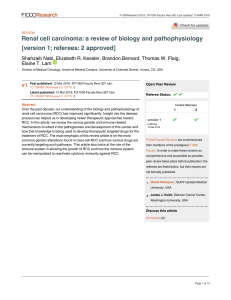
![Robles Campos, Ricardo[Author] - PubMed](http://s2.studylib.es/store/data/005380352_1-a7ed4c0a9d3817acc60b993a8b0de916-300x300.png)
